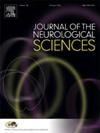自发性脑出血患者心肌肌钙蛋白水平的动态变化现象增加了独立于大血管冠状动脉疾病的住院死亡率
IF 3.2
3区 医学
Q1 CLINICAL NEUROLOGY
引用次数: 0
摘要
背景和目的越来越多的证据表明自发性脑出血(siich)和心肌肌钙蛋白(cTn)水平升高的患者预后更差。虽然siich中孤立cTn升高对预后的预测价值尚不清楚,但很少有研究对随访测量cTn水平的患者进行检查。本研究的目的是探讨高敏感性cTnI (hs-cTnI)水平的动态变化与脑出血患者住院预后的关系。方法回顾性研究纳入2015 - 2021年急性脑出血患者,并进行hs-cTnI水平测定。将hs-cTnI动态变化(即随访测量hs-cTnI水平上升或下降20%)的患者与hs-cTnI水平稳定的患者进行组间比较。采用多变量logistic回归分析对怀疑影响住院死亡率的变量的预测价值进行分析。结果55/105例脑出血患者hs-cTnI水平发生动态变化。hs-cTnI水平的动态变化与住院死亡率显著相关。动态组脑室内出血(IVH)发生率较高,入院时血管危险状况、冠状动脉疾病负担和神经功能状态分布均匀。虽然hs-cTnI水平的动态变化显示出趋势,但仅IVH独立预测住院死亡率。结论hs-cTnI动态是siich沿脑-心轴驱动的急性心肌“撞击”的表达,导致脑卒中性心脏损伤,而不是缺血性心肌梗死。IVH还有助于心肌损伤的病理机制。本文章由计算机程序翻译,如有差异,请以英文原文为准。
The phenomenon of dynamic change of cardiac troponin levels in patients with spontaneous intracerebral hemorrhage increases in-hospital mortality independent of macrovascular coronary artery disease
Background and aims
Growing evidence suggests worse outcomes in patients with spontaneous intracerebral hemorrhage (sICH) and elevated cardiac troponin (cTn) level. While the predictive value of isolated cTn elevation in sICH on outcomes is unclear, few studies have examined patients with follow-up measurement of cTn level. The aim of this study was to investigate the association of a dynamic change in high-sensitivity cTn I (hs-cTnI) levels with in-hospital outcomes in sICH patients.
Methods
This retrospective study included acute sICH patients between 2015 and 2021 with serial hs-cTnI level measurement. Group comparisons were performed between patients with dynamic hs-cTnI change, i.e., rise or fall of hs-cTnI levels on follow-up measurement >20 %, and those with stable hs-cTnI levels. Variables with suspected impact on in-hospital mortality were analyzed for their predictive value using multivariate logistic regression analysis.
Results
A total of 55/105 sICH patients were found to have a dynamic change in hs-cTnI levels. A dynamic change in hs-cTnI levels was significantly associated with in-hospital mortality. Frequency of intraventricular hemorrhage (IVH) was higher in the dynamic group, while vascular risk profile, burden of coronary artery disease and functional neurological status at admission were evenly distributed. While a dynamic change in hs-cTnI levels showed a trend, solely IVH independently predicted in-hospital mortality.
Conclusions
We suggest that a hs-cTnI dynamic is an expression of the acute myocardial ‘hit’ driven by sICH along the brain-heart axis leading to stroke-induced heart injury and not of ischemic myocardial infarction. IVH additionally contributes to the proposed pathomechanism of myocardial injury.
求助全文
通过发布文献求助,成功后即可免费获取论文全文。
去求助
来源期刊

Journal of the Neurological Sciences
医学-临床神经学
CiteScore
7.60
自引率
2.30%
发文量
313
审稿时长
22 days
期刊介绍:
The Journal of the Neurological Sciences provides a medium for the prompt publication of original articles in neurology and neuroscience from around the world. JNS places special emphasis on articles that: 1) provide guidance to clinicians around the world (Best Practices, Global Neurology); 2) report cutting-edge science related to neurology (Basic and Translational Sciences); 3) educate readers about relevant and practical clinical outcomes in neurology (Outcomes Research); and 4) summarize or editorialize the current state of the literature (Reviews, Commentaries, and Editorials).
JNS accepts most types of manuscripts for consideration including original research papers, short communications, reviews, book reviews, letters to the Editor, opinions and editorials. Topics considered will be from neurology-related fields that are of interest to practicing physicians around the world. Examples include neuromuscular diseases, demyelination, atrophies, dementia, neoplasms, infections, epilepsies, disturbances of consciousness, stroke and cerebral circulation, growth and development, plasticity and intermediary metabolism.
 求助内容:
求助内容: 应助结果提醒方式:
应助结果提醒方式:


